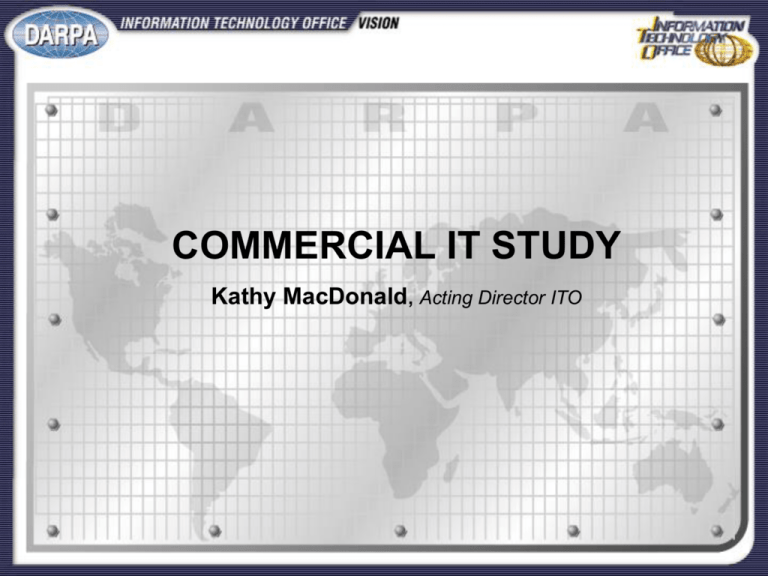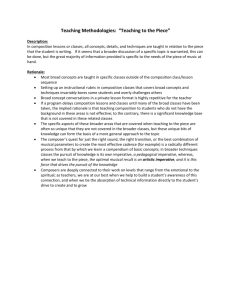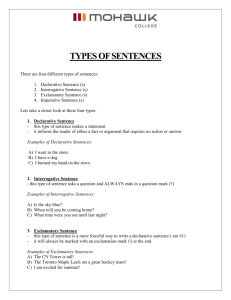ITO_Vision_ - Department of Computer Science & Engineering
advertisement

COMMERCIAL IT STUDY Kathy MacDonald, Acting Director ITO • Purpose of this briefing: to start a dialogue that will lead to the creation of a comprehensive ITO strategy that will facilitate the creation of a New National Security Environment • Briefing Overview: -- Emerging National Security Environment -- Commercial IT directions and investment -- Potential DARPA IT directions -- ITO Mission Statement National Security environment Architecture of technology areas National Security IT imperatives Goals: • Which National Security IT imperatives will the commercial world not address? • Is ITO working on under-addressed IT imperatives? • Are there significant new IT imperatives that ITO should address? Mapping of IT imperatives to technology areas Commercial interviews Commercial coverage UnderAddressed IT imperatives Current DARPA coverage DARPA ITO opportunities Proliferating conventional, WMD and asymmetric threats REQUIRED MANAGEMENT INFRASTRUCTURE : A synchronized national security structure – rapidly applying all components of national power on a global scale TODAY's MANAGEMENT INFRASTRUCTURE: Fragmented service, agency and geographic entities with a “stovepipe” perspective A technical revolution at the point of attack • This restructuring will present scale and complexity issues that far transcend any current non-national security requirements – – • FIT study respondents see little hope of industry answering this challenge at any point in the intermediate to long term future Current and near term engineering practices and network applications can barely keep up with non-national security demands Current Industry R&D efforts are aimed principally at product improvement vs. innovation – Industry optimizes on short term payoffs – 5 years (at most) •DARPA Has Always Set The Pace For The IT Industry –The Agency has been credited with “between a third and a half of all the major innovations in computer science and technology” –Industry Traditionally Has Relied On Government, Academia and Small Companies For Innovation • A tighter linkage between all components of national security power – counter- terrorism calls for a global approach –The Executive Branch is effectively creating a plan to radically transform the institutions and processes created by the National Security Act of 1947 •“Military Overhaul Considered” – 10 Oct Washington Post –The recent Intelligence Community announcement is merely step one •“Intelligence Shakeup Would Boost CIA” – 8 Nov Washington Post • Current planning calls for a global linkage tightly integrating all national security elements from the NCA to the point of attack – – Will lead to a radical restructuring of intermediate command and servicing institutions The Office of Force Transformation (headed by Adm Cebrowski) will move the DoD in this direction BOTTOM LINE: The administration is attempting to create a national security structure for synchronized global warfare Physical –Operate across heterogeneous networks (with varying capabilities) –Command and control of unmanned vehicle fleets (land, air, sea, undersea) –Rapidly deploy & employ flexibly-configured interconnections among units –High degree of interconnectedness –Implement focused logistics Information –Collaborate & interoperate with distributed systems (joint, combined, coalition, OGA, NGA) –Target in real-time, accurately coordinated –Provide high degree of information availability (survivability, reliability, accessibility) –Provide timely, relevant intelligence–national, strategic, & tactical –Operate at multiple levels of information assurance Cognitive – – – – – – Rapidly plan & execute operations plans (inside of enemy's loop) [down echelon] Rapidly plan/monitor/replan operations ("opportunistic ops") [up echelon] Develop and maintain shared battlespace awareness Automate the business rules of warfare (doctrine, procedures, tactics, priorities, techniques) Integrate intelligence, maneuvering, attack, defense, logistics, etc. Adapt to local natural & geopolitical environment Human-computer collaboration Application Enablers (1) Large Scale, Highly Distributed Systems Information integration Agent-based computing Communications Applications Planning and Control Application Enablers (2) Knowledge Intelligent distributed Management resource management Networking Computing Storage Distributed processing infrastructure Pervasive computing foundation Sensors, platforms, weapons, etc. off-board physical systems = Non-ITO Areas = ITO Areas • Commercial – – – – – – Vint Cerf/MCI [Internet pioneer] Marc Andreesen/Loudcloud [Netscape co-founder] Andy Bechtolscheim/Cisco [former Sun CTO] Judy Estrin/Packet Design [former Cisco CTO] Marty Tennenbaum/CommerceOne [e-commerce pioneer] Paul Saffo Institute for the Future [futurist] • Venture funding – Vinod Khosla, Kleiner Perkins Caufield Byers – Dave Liddle/US Venture Partners • University – Jeff Ullman, Hector Garcia-Molina, Gio Wiederhold , Mike Genesereth/Stanford University – Leonard Kleinrock/UCLA • Others Chart maps technology areas to IT imperatives GREEN -- Areas Commercial IT industry is addressing YELLOW -- Areas with limited or no commercial IT investment RED -- Little commercial IT investment DARK GRAY -- Strong DARPA Program coverage LIGHT GRAY -- Limited DARPA Program coverage UNSHADED AREAS -- No DARPA Program coverage ITO VISION STATEMENT ITO will create the future of information technology - enabling the creation of tomorrow's national security infrastructure ITO MISSION STATEMENT •Create breakthrough information technologies that will ensure the strategic application of US national power -- that meets the IT imperatives for the future -- that will not be developed adequately by the commercial world • Demonstrate these technologies in the context of real military problems • Transition these technologies to military and other users, via partnerships with other DARPA offices and industry BACKUPS • • • Based on the technology needed to fulfill the IT imperatives of the future that are not going to be met by the commercial world, ITO will focus on key aspects of: – Human-computer collaboration – Information integration – Knowledge management – Decision support [??] – Agent-based systems – Distributed intelligent resource management – Communications, networking, computing, and storage – Architecture and design Next steps – Get PM inputs – Etc. Implementation Commercial Interviews (complete) [1 of 2] • Commercial – – – – – – – – – – – – – – Vint Cerf/MCI, Chief Scientist [Internet pioneer] Marc Andreesen/Loudcloud, CEO [Netscape co-founder] Andy Bechtolscheim, David Cheriton/Cisco [former Sun CTO] Judy Estrin/Packet Design, CEO [former Cisco CTO] Bradley Horowitz/Virage Marty Tennenbaum/CommerceOne, SVP & Chief Scientist [ecommerce pioneer] Jim Gosling, Jim Mitchell, Danny Cohen/Sun Microsystems Bill Crowell/Cylink, President & CEO [former Deputy Director, NSA] Son Dao/X-Laboratories Eric Horvitz/Microsoft Paul Saffo/Institute for the Future, Director Avron Barr/Aldo Ventures, Principal Stan Honey/Sportvision, President & CTO Dave Brandin Commercial Interviews (complete) [2 of 2] • Venture funding – Vinod Khosla/Kleiner Perkins Caufield & Byers, Partner – Dave Liddle/US Venture Partners – Mark Seagal/Menlo Ventures • University – Jeff Ullman, Hector Garcia-Molina, Gio Wiederhold , Mike Genesereth/Stanford University (Computer Science) – Doug Brutlag/Stanford University (Medical School) – Leonard Kleinrock/UCLA – Jonathan Smith/University of Pennsylvania Potential Areas for ITO Programs [1 of 5] • Human-Computer Collaboration – Advanced visualization – Mixed-initiative information processing • Information Integration – – – – – – Adaptive information fusion Multimedia (text, data, imagery, video, etc.) understanding Integrated media processing Very-large-scale sensor grid processing Speech processing Multilingual language processing Potential Areas for ITO Programs [2 of 5] • Knowledge Management – – – – – Metadata processing Search and retrieval of multimedia Data pedigree/history Reasoning under uncertainty Semantic component description for reusability • Decision Support – Very-large-scale planning/monitoring/replanning – Distributed collaboration and decision-making Potential Areas for ITO Programs [3 of 5] • Agent-based Computing – – – – – Service agents Dynamic configuration of agent systems Control of agent-based systems Distributed simulations Distributed semi-autonomous systems (robotics) • Intelligent Distributed Resource Management – Intelligent data provisioning (store vs. compute vs. send, push vs. pull, user profiling) – Distributed storage & migration of data – Exploitation of distributed computing – Power-aware computing in distributed environments Potential Areas for ITO Programs [4 of 5] • Communications – Novel protocols for defense environments (anti-jam, low probability of intercept, urban, mobile, etc.) • Networking – – – – Quality-of-service provisioning Self-configuring networks of networks Very large wireless networks Network modeling and performance analysis • Computing – Power-aware computing devices – Highly distributed massive computers – Self-managing (self-aware, self-configuring, self-maintaining, selfrepairing) computers – Advanced hardware architectures (and programming them) – Highly reliable computers (including with unreliable components) – Unconventional computing (quantum, biological, etc.) Potential Areas for ITO Programs [5 of 5] • Storage – Very large data storage – Multimedia data storage • Architecture and Design – – – – – – – Design of complex distributed systems Distributed systems verification Requirements engineering Distributed systems performance analysis Design for interoperability Architectural trade-offs of processing/storage/communications System componentization optimization • Security – Designed-in, built-in trust – Distributed trusted systems • • • • • • • Quadrennial Defense Review 2001 Executive Order: Office of Homeland Security Joint Vision 2020 Network Centric Warfare Report to Congress Defense Science Board 2000 Summer Study – Protecting the Homeland A Non-Standard Process – Interrupted By a Major Attack on the United States But, What Constitutes “Information Superiority”? 29 • Joint forces scalable, task-organized into modular units • Highly networked with joint Command/Control • Light, lethal, maneuverable, survivable, readily deployed/employed in integrated fashion • Conduct distributed and dispersed operations • Plan and execute faster than enemy, seizing tactical opportunities • Joint/combined Command and Control • Network Centric Warfare is a warfighting concept that allows us to achieve Joint Vision 2020 operational capabilities. • NCW allows the force to achieve an asymmetric information advantage. – Dramatically improved capabilities for sharing of information • Coupled with enhanced capabilities for sensing, information sharing can enable a force to realize the full potential of Full Spectrum Dominance. Relationships in warfare that take place simultaneously in and among the three domains: Physical Domain: domain where strike, protect, and maneuver take place across the ground, sea, air, and space environments; it includes the physical platforms and the communications networks that connect them reside. Information Domain: domain where information is created, manipulated, and shared; where command and control is communicated. Cognitive Domain: domain of the mind; elements are the intangibles of leadership, morale, unit cohesion, level of training and experience, situational awareness, and public opinion; also residing here are commander’s intent, doctrine, tactics, techniques, and procedures. Provide timely, relevant intelligence - national, strategic, & tactical • Human-computer visualization for intelligence will require advances beyond the commercial world, which tends to focus on data visualization where there is statistical significance, vice semantic visualization of rare events for the intelligence problem. • Information integration, knowledge management, and decision support will all require significant advances beyond that of the commercial products, which will not apply to the “needle in the haystack” kinds of intelligence problems and the volumes of data to be addressed. • Agent-based computing and intelligent distributed resource management for intelligence will be able to take significant advantage of commercial developments, but the scale of the intelligence problem, coupled with the distributed nature of the collection and processing, will present special demands that the commercial world will not address. • We also expect that the commercial products will be the primary source of capabilities for communications, networking, and storage, but the stressing requirements may require some amount of specialized capabilities. • The power and capability of off-the-shelf computing devices is expected to suffice, since there are few stressing requirements (possibly tactical intelligence will have time-stress requirements, but it seems unlikely that custom hardware is appropriate here). • The intelligence problems will present significant architecture & design issues beyond that which the commercial world will address, due to the highly decentralized nature of the processing and the need for semantic interoperation. • Security Develop and maintain shared battlespace awareness • Human-computer visualization for battlespace awareness will require advances beyond the commercial world, particularly in immersive environments. • Information integration and knowledge management will require significant advances beyond that of the commercial products, due to the large volumes of disparate data that needs to be integrated and the diverse knowledge that needs to be managed. • Decision support is not expected to play a part in this imperative, since no real decision-making is taking place. • Agent-based computing and intelligent distributed resource management for battlespace awareness will be able to take significant advantage of commercial developments, but the scale of the this problem, coupled with the distributed nature of the collection and processing, will present special demands that the commercial world will not address. • We also expect that the commercial products will be the primary source of capabilities for communications, networking, and storage, but the stressing requirements may require some amount of specialized capabilities. • The power and capability of off-the-shelf computing devices is expected to suffice, since there are few stressing requirements for battlespace awareness. • The battlespace awareness problems will present significant architecture & design issues beyond that which the commercial world will address, due to the highly decentralized nature of the processing and the need for semantic interoperation. • Security Rapidly plan/monitor/replan operations ("opportunistic operations") [up echelon] Human-computer collaboration for planning on the scale of a full-up task force will require collaboration methods beyond the commercial world, especially in mixed-initiative planning approaches and explanation of automated planning algorithms. Information integration and decision support for planning will use many of the database-oriented commercial developments, but there will still be significant requirements not met by the commercial world, particularly in the integration of semantic information for planning. The heterogeneous types of knowledge that are needed for planning demand knowledge management approaches far in excess of the commercial world, which tends to focus on document management in homogeneous environments. Agent-based computing and intelligent distributed resource management for planning will be able to take significant advantage of commercial developments, but the scale of the this problem, coupled with the requirements for rapid response for replanning, will present special demands that the commercial world will not address. The power and capability of off-the-shelf communications, networking, computing devices, and storage are expected to suffice, since there are few stressing requirements for planning in these technical areas. The planning and replanning problems will present some architecture & design issues beyond that which the commercial world will address, due to the need for semantic interoperation and the diverse set of types of assets whose use needs to be planned. Security Rapidly plan & execute operations (inside of enemy's loop) [down echelon] v Human-computer collaboration for planning and executing rapidly will require collaboration methods beyond the commercial world, especially in mixed-initiative planning approaches and explanation of automated planning algorithms. v Information integration, knowledge management, and decision support for rapid planning and execution will not need significant advances over the commercial developments, since the problem is not stressing in these technical areas, but there will still be requirements not met by the commercial world in the integration of semantic information. v Agent-based computing and intelligent distributed resource management for planning will be able to take significant advantage of commercial developments, but the requirements for rapid planning and execution will present special demands that the commercial world will not address. v The power and capability of off-the-shelf storage solutions are expected to suffice, since there is not a need for storage of large amounts of data, but communications, networking, computing devices will need additional capabilities than afforded by the commercial world in order to meet the rapid timelines expected. v The rapid planning and execution problems will present some architecture & design issues beyond that which the commercial world will address, due to the need for rapid response to be built into the design and the need for semantic interoperation. Security Target in real-time, accurately, coordinated • Human-computer collaboration will have little role in targeting in real-time, so commercial approaches should suffice. • The stressing information integration and knowledge management requirements will be done in planning, while in targeting there is less requirement for both functions, so the commercial products will help. On the other hand, the stressing timelines and the coordination among (possibly) disparate units require approaches beyond what is expected to be available in commercial products. • There will be little need for decision support, so the commercial world will most likely address this technical area. • Agent-based computing for coordinated rapid planning and execution will be able to take significant advantage of commercial developments, but the timeliness requirements for coordination will present special demands that the commercial world will not address. • Intelligent distributed resource management is the “main event” of targeting, and the commercial world is unlikely to produce products that will allow the speed and accuracy needed required, especially with the coordination among disparate units. • Communications, networking, and computing will all require some capabilities beyond the commercial developments, due to the real-time nature of this imperative, but it is expected that significant commercial capabilities will be able to be the underpinning of targeting, since there are real-time requirements in manufacturing, process control, embedded systems, etc. in the commercial world. • It is not expected that storage of large amounts of information, nor rapid access (quicker than transactionbased applications), will be any more difficult to implement than in the commercial world, so full advantage of the available products should provide what is required. • The speed with which targeting needs to occur will present significant architecture & design issues beyond that which the commercial world will address, due to the need for real-time behavior to be built into the design. • Security Command and control of unmanned vehicle fleets (land, air, sea, undersea) • Human-computer collaboration is vital to command and control of unmanned vehicle fleets, since telerobotic control is expected to be a major operating mode. There are many developments in the commercial world that can apply to this technical area, but additional work will be needed to provide the required feedback from the vehicles and to command the fleet (vice a single vehicle). • The integration of information from the vehicle fleet in a reasonable way for the humans providing the command and control will need capabilities well beyond what is expected to be seen in the commercial world. • Knowledge management and decision support for command and control of unmanned vehicle fleets has some requirements beyond what the commercial world is likely to see, but not so many that the commercial developments will provide important capabilities. Particularly in decision support, we would expect needs beyond what the commercial products will provide. • Agent-based computing will be needed to coordinate the elements of the fleet, but as there will be a relatively small number of these elements the commercial developments will probably provide a sufficient basis, with additional work needed in the real-time control aspects of this imperative. • Intelligent distributed resource management will be needed to allocate resources among the units of the fleet, and whereas commercial products are addressing similar problems, they do not have the real-time requirements nor man-in-the-loop requirements of this imperative, so it is expected that additional capability must be added. • Communications, networking, computing, and storage developments in the commercial world will probably provide most of the capabilities for the needs of command and control of unmanned vehicle fleets, but the environments that they have to work (battle, airborne, sea and undersea) are stressing and it is expected that the commercial world will not meet all the requirements. • The architecture & design of such vehicle fleets, with their coordination needs and real-time control, will be able to be done in part with commercial approaches, but there are enough stressing requirements of this IT imperative that will not be present in the commercial world to demand novel techniques that will need development. • Security Implement focused logistics • Human-computer collaboration for logistics will be able to take advantage of commercial work, since there are plenty of commercial logistics efforts that will have a subset of the requirements of this imperative, but additional capabilities will need to be developed for the unique requirements of this imperative. • Information integration, knowledge management, decision support, and agent-based computing for focused logistics will all be able to use commercial capabilities, but extensions are needed due to the wide variety of locations, resources, movement types, security, and other requirements that this IT imperative will have over the commercial world. • Intelligent distributed resource management, communications, computing, and storage will not require any special capabilities beyond that of the commercial world, since the commercial logistics companies have much the same requirements as national security. Networking, on the other hand, will take much of its capabilities from the commercial world but will require additional capabilities due to the unique environment in which it must work (multiple heterogeneous networks interconnected in novel ways). • Architecture & design of such highly distributed logistics operations is beyond the state-of-the-practice of commercial approaches, although their products can form the basis of what is needed. • Security Integrate intelligence, maneuvering, attack, defense, logistics, etc. • Human-computer collaboration for this IT imperative is very difficult, and whereas some needed capabilities are similar to those being developed in the commercial world, the integration of such diverse domains requires significant additional specialized techniques of human-computer collaboration, from visualization to mixed-initiative decision-making. • Due to the stressing needs to integrate such diverse sets of information for this imperative, to the widely disparate domains that must be covered with knowledge, and to the difficulty of decision-making in such a broad area of discourse, significant new capabilities will have to be developed, where the commercial world has no requirements and thus is unlikely to develop any capability of significance to apply. • Agent-based computing will be the “glue” that will allow the required integration, at the semantic level, and as such is a critical part of this imperative. The developments in the commercial world may very well provide the basis for agent-based computing, but significant new capabilities will have to be layered on top of this basis to meet the requirements of this imperative. • Intelligent distributed resource management will be a part of this IT imperative, although it is not the major focus. As such, much of what will be needed can come from commercial developments, although the allocation of resources (such as computing and communications) over such diverse sets of functions will require additional capabilities to be developed. • Communications, networking, and storage for integration of such disparate functions will largely come from commercial developments, although the stressing nature of such integration may require additional capabilities to meet the imperative’s requirements. The computing requirements, on the other hand, are likely to be fully met from the commercial world. • Architecture & design of such a highly distributed system of such disparate parts is bound to be difficult, and whereas commercial design tools are likely to play a part, they are unlikely to address the semantic diversity of the information in this imperative, as well as the stressing data dissemination requirements. • Security Collaborate & interoperate with distributed systems - joint, combined, coalition, OGA, NGA • Human-computer collaboration for collaboration and interoperation will be challenging across such a disparate set of users, but it is expected that significant commercial work will apply, but not sufficient for all requirements. • Information integration across such a wide variety of users is a significant challenge, especially in the semantics of the objects that are in the domain of application. Significant new capabilities will need to be developed that the commercial world doesn’t need and thus is unlikely to produce. • Knowledge management, decision support, and agent-based computing will be vital functions for collaboration and interoperation across distributed systems, and whereas the commercial world is developing capabilities that will undoubtedly be of use, it is not expected that the levels of functionality in managing and decision-making with the wide disparity of semantics and formats of domain objects will suffice. • Intelligent distributed resource management is not expected to play a part in this imperative. •Whereas the commercial developments in computing and storage are expected to suffice, based on the requirements of equivalent commercial systems that collaborate and interoperate, the communications and networking are expected to be more stressing (especially in their need for automated configuration and reconfiguration in response to battle damage) for national security applications than in the commercial world, and hence will need additional capabilities. • Architecture & design of such highly distributed systems of such disparate components is beyond the expected state-of-the-practice in the commercial world, but the commercial products are expected to provide significant capabilities upon which the requirements of this IT imperative may be built. • Security Rapidly deploy and employ flexibly configured interconnections among units • Human-computer collaboration and knowledge management are expected to play only a minor role in this imperative, and thus the commercial world will develop all that is needed, given their similar demands. • Information integration and decision support are not expected to play a part in this imperative. • Agent-based computing will play an important role in the negotiations among units to configure themselves. As such, it is an important part of this imperative, which the commercial advances in agent-based systems will contribute to, but the rapidity of configuration and the flexibility requires capabilities beyond that of the commercial products. • Intelligent distributed resource management is paramount for this imperative, but the commercial world will attack similar enough problems that it is expected that significant capabilities will be available. However, the commercial products are unlikely to have the time requirements and reconfiguration requirements that the national security has, so it is expected that additional capabilities will need to be added. • Communications and networking advances beyond the commercial capabilities will be needed for the speed and flexibility for this imperative, but much of the commercial work in this area will be able to be used. • Computing and storage are not expected to play a part in this imperative. • Architecture & design for such speed and flexibility will require capabilities beyond that available from the commercial world. • Security High degree of interconnectedness • Human-computer collaboration is not expected to play a part in this imperative. • The requirements for information integration and knowledge management will be simple enough for this IT imperative that it is expected that the commercial products will suffice. • Decision support is not expected to play a part in this imperative. • Agent-based computing and intelligent distributed resource management will be the application-level functions to implement a high degree of interconnectedness, and as such will be based on commercial approaches. However, the unique national security environments, where the capabilities and constraints of networks are heterogeneous and widely disparate, will require additional capabilities beyond that of the commercial world. • Communications and networking likewise will be based on commercial products, but as in agent-based computing and intelligent distributed resource management additional capabilities will be needed to meet this imperative’s requirements. • There are expected to be no unique computing requirements for this imperative, so commercial capabilities will suffice. • Storage is not expected to play a part in this imperative. • Architecture and design for connecting widely disparate communications and networks to implement the requirements of this imperative will need capabilities that are beyond what the commercial world needs and is likely to produce. • Security Adapt to local natural and geopolitical environment • Human-computer collaboration, computing and storage for adapting to local environments is expected to be no more stressing than those of commercial applications, so the commercial approaches should suffice. • Information integration, knowledge management, and decision support for this imperative will present special requirements beyond what the commercial world will see and respond to, especially in the “sensing” of the local environment and rapidly adapting to it, although it is expected that some capabilities can be used from similar, but less stressing, commercial developments. • Agent-based computing will be a key part of adapting to local environments, and whereas the commercial approaches will help meet the needs, additional capabilities will be needed for “sensing” the environment and rapid response. • Intelligent distributed resource management is another key to this imperative, since adaptation implies applying resources available adaptively and rapidly. Although commercial products will address some of the requirements, due to their having similar but less stressing needs for adaptation, it is expected that they will not address all the needs. • Communications and networking will largely come from the commercial world, since there are no unique requirements to meet this imperative, but the integration of communications and networking with local environments and the ability to adapt may place additional requirements on the commercial approaches. • The architecture of adaptive systems and the design of such systems will need enhancements to the commercial approaches to system design, due to the unknown local environment to which national security systems must adapt and the flexibility and speed of adaptation needed. • Security Provide high degree of information availability (survivability and reliability and accessibility) • Human-computer collaboration is not expected to play a part in this imperative. • Information integration will be needed to for the algorithms to understand the information involved that must be made available, to a degree that will not be able to be handled by commercial approaches, although there are likely to be some commercial approaches that are usable. Knowledge management for the understanding of the information will have to work in unique environments, and thus additional capabilities beyond commercially available will be needed. • Decision support is not expected to play a part in this imperative. • Agent-based computing will provide important infrastructure for high availability of information, which, due to the unique requirements of national security environments, will require advances beyond what commercial approaches are likely to provide. • Intelligent distributed resource management will play a vital role for this imperative, for undoubtedly one means of making information available is to migrate it around networks, which is essentially a resource allocation problem. It is expected that data replication and other approaches from the commercial world will apply, but that significant enhancements will be necessary due to this imperative’s requirements, such as to work on the unique communications and networks. • Communications and networking for high availability of information are expected to be available largely from the commercial world. There are no particular requirements of this imperative that would indicate a need beyond commercial products. • Computing is not expected to play a part in this imperative. • Storage will be an important part of information availability, for the migration of information around networks will be closely connected to the intermediate and replicated storage of the data. Whereas the database and object storage approaches in the commercial world will provide a solid basis, the specific requirements of this imperative will require additional capabilities to deal with the unique environments in which the storage will have to operate. • Architecture and design of such distributed, adaptive systems is beyond the commercial state-ofthe-practice, and is likely to remain so, but it is expected that commercial approaches can form the basis for architecture and design of these approaches. • Security Automate the business rules of warfare (doctrine, procedures, tactics, priorities, techniques) • Human-computer collaboration will be important for expressing and analyzing the business rules of warfare, and whereas commercial visualization and analysis techniques may be usable, it is expected that additional capabilities will be needed to meet the unique national security requirements. • Information integration is not expected to play a part in this imperative. • Knowledge management is the “main event” in this imperative, and how the business rules are expressed and maintained, and how they are used in information processing, will benefit from similar needs in the commercial world, but the unique requirements of national security applications using this knowledge (the business rules of warfare) will require additional capabilities. • Decision support is likely to be needed for analyzing and validating the business rules, and the capabilities needed will be added to commercial approaches for analyzing and validating rules in similar contexts. • Agent-based computing will be the basis for sharing business rule processing and knowledge management among distributed applications. The approaches in the commercial world for this technical area will form the basis of this imperative, but it is unlikely that commercial approaches will deal sufficiently with all the national security requirements. • Intelligent distributed resource management, communications, networking, computing, and storage are not expected to play a part in this imperative. • Architecture and design is unlikely to be a serious problem in this imperative, so it is expected that commercial approaches to this technical area will suffice. • Security









